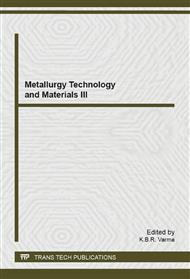p.146
p.151
p.156
p.163
p.168
p.173
p.180
p.185
p.190
Application of Super Conducting High Gradient Magnetic Separation Technology on Resource Utilization of Low Grade Iron Ore
Abstract:
Nowadays, steel industry develops rapidly. However, lots of iron ore needed by China’s steel industry are imported from abroad. China’s dependence on foreign iron ore exceeds 70%. As a result, not only have large amounts of foreign currencies been spent but also a potential threat has been posed to the economic development of our country. Therefore, it is necessary for China to serve its economic production with lots of low grade iron ore. Since traditional beneficiation methods can cause serious environmental problems, High gradient magnetic separation(HGMS) is discussed in this paper. It can recycle tailings when disposing of low grade iron ore as well as solve the environmental problems caused by tailings and arising during the production process. Besides, high gradient magnetic separator can also raise the processing efficiency of low grade iron core. Therefore, high-gradient magnetic separation can not only increase economic returns but also protect ecological environment. With the maturity of super-conduction high gradient magnetic separation technology, super-conducting high gradient magnetic separation will produce better production effects.
Info:
Periodical:
Pages:
168-172
Citation:
Online since:
June 2014
Authors:
Price:
Сopyright:
© 2014 Trans Tech Publications Ltd. All Rights Reserved
Share:
Citation:


